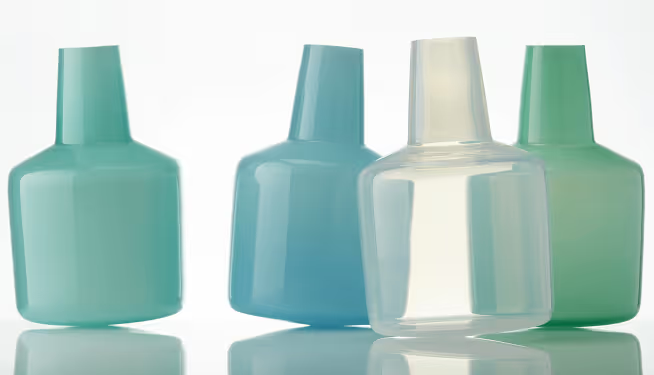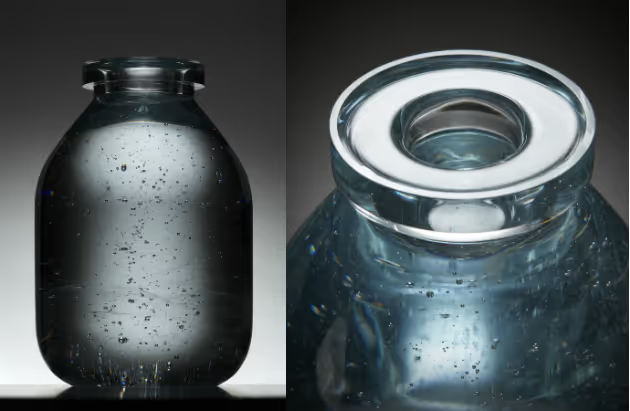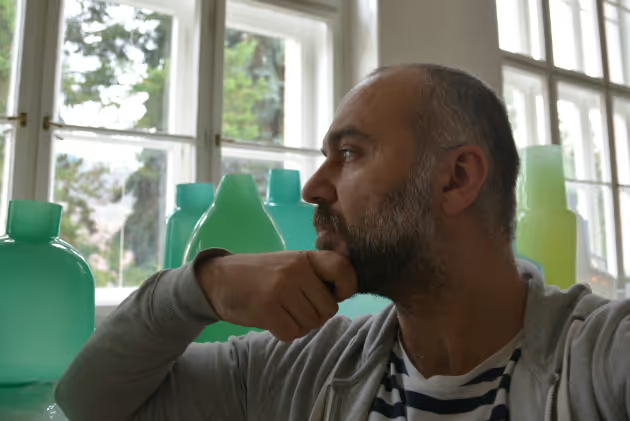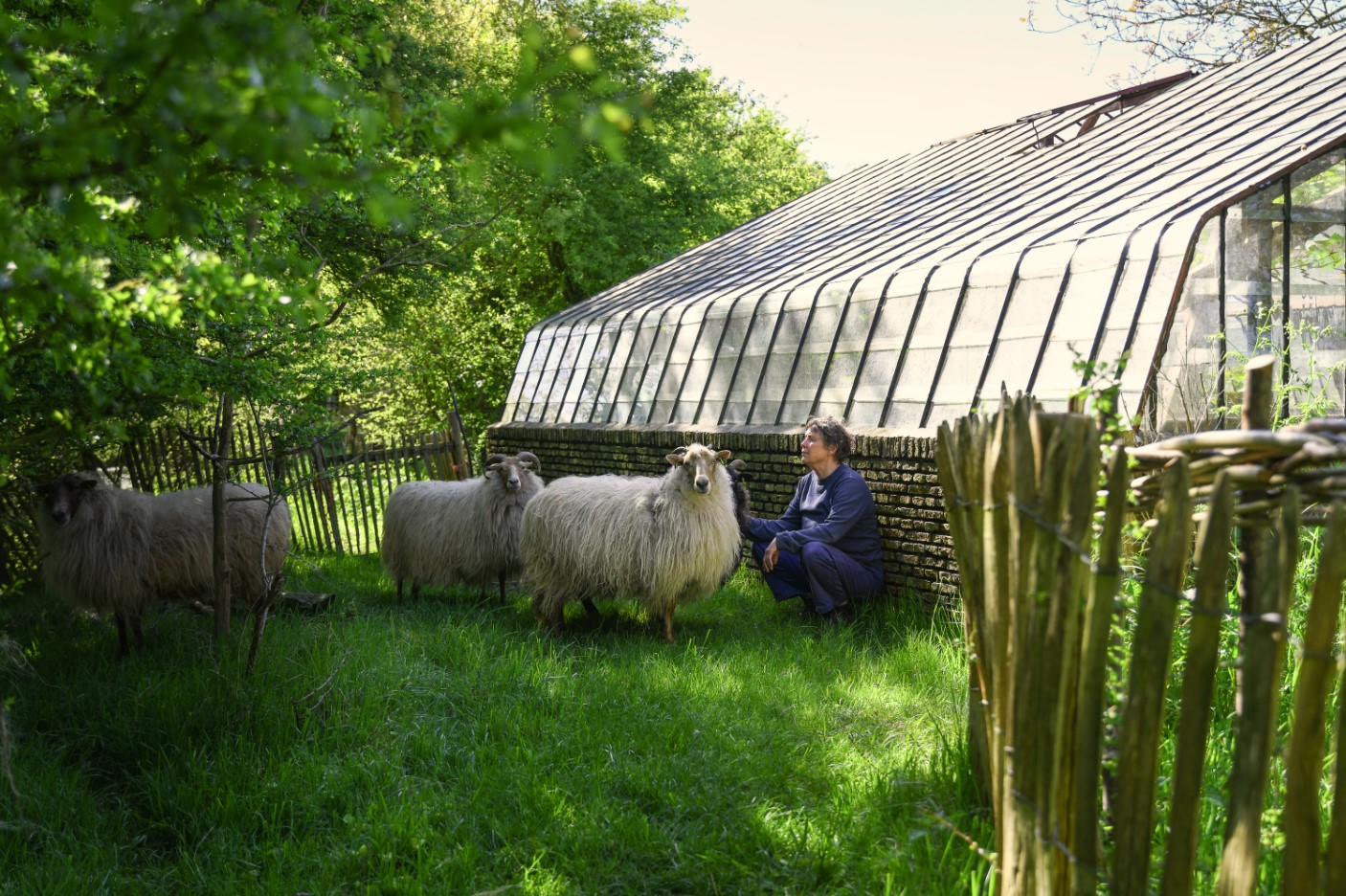► českou verzi rozhovoru najdete zde
Apart from glassmaking, you have also studied sculpture, worked with wood and sandstone. During your internship in Slovenia, you focused on Plečnik. But then you returned to glass.
I come from Železný Brod. My parents worked with glass, glass was all around me and the option for me to do something else wasn't really there. I studied glass at both secondary school and university. But my sculpture courses with professor Michal Gabriel were also important. He was very progressive. It's pretty much standard these days, but back in 1999, the school studios were only starting to experiment with different materials while he already worked with polyester resins and other stuff. I didn't even think I'd be returning to glass then.
But you have...
After university, they offered me a teaching job back at Železný Brod, at the school I graduated from. That was a challenge, the school was renowned. I didn't know what else to do so I accepted. You know how it goes after university. It's not easy. I learned how to do models in my sculpture classes and then came back to glass through mold-melted.
Do you think you are going to make a detour again?
I don't know. I don't want this to sound arrogant, but I'm surprised I'm still doing this. Mould-melted glass is very demanding. It's time-consuming, costly and technologically challenging. It's an expensive hobby; I only do two to three pieces a year.
Would you consider another material, something cheaper and less time-consuming?
I don't know. I've just done this experiment I'm still recovering from, but that was still with glass. I tried glass blowing last year. A decent set of vases came out of it. I was surprised, not sure if pleasantly surprised, how fast it went. I think it's almost dangerous in a way. When you're doing a mold-melted glass piece, you have it in your head for a long time. You have to decide which shape is right and then you work on it for three to five months. With blown glass, you just get a mold made and then it's done in one or two hours. You see the shape immediately. It's attractive, but I'm still a bit hesitant.

Buoys, layered glass, blown into a rotation mold, cut, 2014
You used pastel colours for your blown Buoys, and then very dark, almost black glass for another set. How do you see this colour experiment? Do you feel closer to one of the sets?
I always saw the Buoys in sort of milky blue and green colours; I wanted them to resemble the ones in the channels of Venice, for the colour to match the shape. I got a colour chart from the glass producer. They said nobody wanted these washed out colours. But I wanted them like that from the start and I was quite happy. The black ones, that's a different story. I like that in glass, it's the most sculpture-like colour. It's great at accentuating the shape; there are no optical effects to distract you. Some people say it's like stone or plastic, but that's exactly what I like. In the spring, I will be doing another set of about seven shapes. I'm trying to assign colours to them, there'll probably be transparent and light colours. But it could all end up as nonsense, you never know.
Isn't this how design as such is done?
People keep arguing whether my work is design or not. All my vessels can be used, but I don't perceive them as utilities. With the Buoys, we turned the mold around for some, so they don't have a hole, the bottom is on top. That's how we're going to show them, I thought, sop that everyone knows I'm after the shape, not the use. But in the end we shoved vases anyway. There's this conflict in me.
But you only showed the vases in limited numbers, assembled into kind of nests.
I usually just do one original. The Buoys have a hint of inflation about them. You can make lots of them relatively easy. Every designer dreams about having their glass in all restaurants, get it out there. Me, I don't have the answer to why my piece should be produced in series of hundreds of thousands. Art and uniqueness is more important to me. Over eleven years, I've done forty one pieces. I think that's enough. There's no sense in infesting the world with Hlubuček.


Buoys, layered glass, blown into a rotation mold, cut, 2014
Let's go back to black glass for a while. The Buoys are not the only black objects you've created.
The first black mold-melted piece was an incident. It was supposed to be ruby glass, with gold. What I didn't know at the time was that ruby glass is exceptionally sensitive to temperature and I got black, 'burned' glass. But the result after cutting was absolutely stunning. The next object was intentionally black. So I said to myself - is black going to be my colour? In the end it doesn't look that way. Once in a while, about every two years, I can't help it and a new black thing comes. When you think of it, it's strange making black things out of glass when you can make them out of something else. It's as if you deliberately took the transparency away.
It almost sounds as if shape is more important for you than..
... than the glass itself, well, that's a bit of a blasphemy. I think putting the shape first is the result of my sculpture training.
You keep saying we, ours, who are you referring to?
We are my cutter Lukáš Košťál and myself. I keep thanking him in all catalogues and anywhere possible. I model the piece, make the mold, stoke the kiln, and pour the glass in the mold. But I never studied cutting. Eleven years ago, I found a budding cutter and I've never used anybody else. Lukáš is very exact, but what's more important, he now understands how I think. There's nobody here, perhaps with the exception of Gizela Šabóková, who does the entire technology from A to Z. Everyone in this profession has to have at least one other person. Some only draw the thing or model it in 3D and then have it made. That's not acceptable to me. I try to spend as much time with every object as possible.
Can we say the craftsmen are co-authors of the piece then?
Yes. We're being very bad to master craftsmen here in the Czech Republic. In some countries, the author signs the piece with them. Here, it's impossible to find a glasshouse worker's signature on a vase. The craftsmen are in the shadow of the artists, and that's not fair.
Martin Janecký includes the name of the person he's working with.
Yes. He's used to it from the States, where they know there wouldn't be anything without craftsmen.
Can you imagine learning cutting yourself?
I know a bit about some glassmaking techniques, I spent ten years with a burner, I can cut a vase so that it stands right.... But cutting a mold-melted piece is a specific form of sculpting.
You said about your work: "I'm reducing the pre-existing, I go for the core of shape." Are you inspired by history, or working with archetypes based on your experience?
I don't have a definite answer to that. I saw lots of different shapes and vessels during my travels and in museums. I already had some of them sketched. A designer would be disappointed that his thing already exists, I find it satisfying.
Can you give an example?
When I travel halfway across Europe to see something I sketched in a completely different context, as part of a two thousand years old stone baptistery for instance, it's a sign for me that I'm on the right path. It doesn't work the other way around – go to a museum and do a copy cat.
Where do you get inspiration from then?
It's not from working with compass and ruler. I'm interested in the story of shape When I'm interested in a Greek architrave detail, I work with scale. I try whether it will still work on the edge of a bowl. Maybe it's not normal to keep doing vessels, but I collect shapes and ideas, sketch them and then leave them for a year or two. I come back to them then to see whether they still work.
What do you mean by them working?
Some shapes are universal. Some call them archetypes. Such shapes make us happy, are familiar, bring out calm and intimate feelings in us.
You said that you don't see your pieces as utilities. Does a vessel have to contain anything? If you were to fill yours, what would you use?
I don't mind when somebody puts nuts or flowers into my pieces, but I don't expect it and it sometimes surprises me. (laughter) I think about every millimetre, about proportions, texture of the surface. When you put a bouquet of flowers into a piece, the composition becomes unimportant.

Bouteille, mold-melted glass, 33, 5 x 20 x 22, 5 cm, 2012
Do you think that someone who fills one of your pieces didn't get your idea?
No. Different people buy things for different reasons. You have snobs who buy things without knowing why. But there also are people who understand me. Last year, a gentleman bought two black pieces in Paris. It was during the opening night. I got to talk to everyone and explain my work. This gentleman was standing by two black bowls all the time and then said he'd like to buy one but can't decide which, what would I recommend. I said he should buy them both. He laughed, but he did it anyway. I later found that he was a well-known philanthropist and glass collector. I like that, because these two bowls are looked at by someone who understands glass every day.
You said that a vessel is defined by the possibility of holding something. You don't work with that, but your pieces are hollow.
I realised that the ratio between the inner space and the piece itself is getting smaller. I guess I am fighting utilitarianism. Professor Gabriel used to say that the only sensible thing is free art, ideas in matter. A teapot and a plate make sense – they are utilitarian, but art communicates a higher idea.
Can you expand on that?
I did design at both secondary school and university. I never thought of myself as ready to do free art. Even when I make a really heavy vase, which virtually can't be used, the function is still there. But I don't expect anybody to use it as such. One day when the hollow space is not there at all, I guess it'll be a sculpture then.
Do you ever scrap something straight out of the mould and then regret you haven't finished it?
I am sometimes disappointed, but I let it sit for a while. I look at the thing and wait for a month or two, or even half a year. I'm deciding whether to put another hundred and fifty hours of work into it. We cut one piece four years after it left the mold. With others, I wanted them cut straight away and I now hate them.
Have you sold some of those?
Yes, but I don't know whether that's a good thing. I don't like them much. But that doesn't mean they are not important. I'm still surprised that things which look great may come up shallow, and vice-versa. Some don't make it because of the technology The graveyard, that's what I call the place those things go to, is quite big. Mould-melted glass is the most complicated glassmaking technique in this regard.
Do you have pieces you wish you haven't sold?
You can't think in this way. I hope they are in good hands and people enjoy them. I got to do another piece with the money. When I think of it, I have about three pieces I would want to have.
Which are they?
The Vaticano bowl, for instance. It was an experiment and we don't know the composition of the glass, so we can't replicate it. I would also not sell Bouteille today.

Vaticano, mold-melted glass, 44 × 20 × 16 cm, 2010
Apart from your art work, you have been teaching at the Železný Brod glassmaking school for fourteen years now. What do you think about how glassmakers are being educated?
The vocational school system in the Czech Republic is pretty special. Elsewhere in the world, practical skills come later, but here 14 year old kids are learning the craft. It's still about being a renaissance person, start early, train the hands, and start with drawing. In the West, students come to art schools at 19 and find it difficult. I have visitors from universities every other week and they all say the same – how comes kids can do something this good.
Do you see any problems in our secondary school system?
There are too many schools, 480 art and craft majors. When I was young if you wanted to do porcelain, you went to Karlovy Vary, if you wanted to do glass, you went to Železný Brod. It was clearly drawn and the best students and best teachers were there. After the revolution, the market changed, new schools appeared and then the 14 regions were established in 2000. Every region started its own educational programme. But the number of talented kids is the same and now the schools are fighting for them. When I was doing the entrance exam, they selected 30 out of 160. Now 20 apply and you are supposed to have 30. There's no vision behind vocational schools. And that's a shame.
We hear it from all sides – mediocre students chase the best teachers away, but mediocre teachers do not attract the best students. Granát in Turnov is apparently desperate for precious stone cutters and they can't find a single one.
There's a missing generation, we already know that. The glassmaking industry has come up from the bottom. Companies now have contracts, but there's nobody to work on them. Imagine customers want your product, but you don't have anyone to make it. Manufacturers tour the schools and beg students to work for them. We've been saying that there was not going to be enough people for five or eight years now. Many big companies thought they didn't need technology specialists, but now they realise their core employees are going to retire in a few years.
And when you only teach a fraction of students they may not be the best ones to carry the torch....
Very true. We always say that it's a success if one person from every year stays in glass. But that hasn't been happening for a number of years
Why so many drop out?
It's difficult to choose your profession at the age of 14. There are so many possibilities and the kids are not ready. But I hope arts and crafts develop aesthetic abilities in them. It's not a bad thing when they decide to do something different during or after school. Our former head teacher used to say it didn't matter when our graduates did. Even if they end up running a pub, we can be sure it will at least be tastefully decorated. Our students know a bit about history of art, some end up as conservationists. The school is also contributing to the society in this way.




%20(2)%20kopie.jpg)